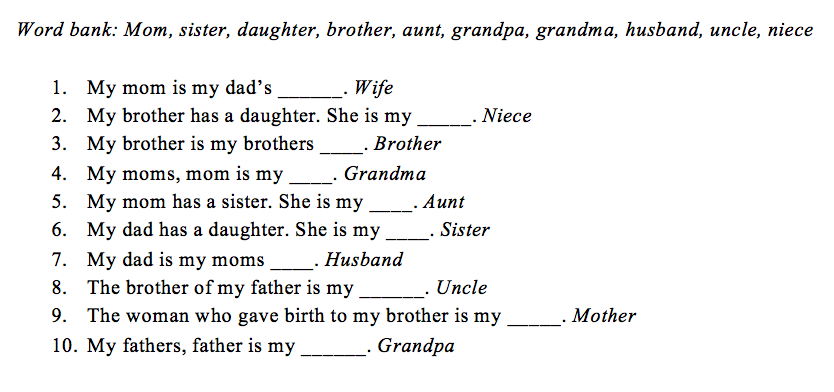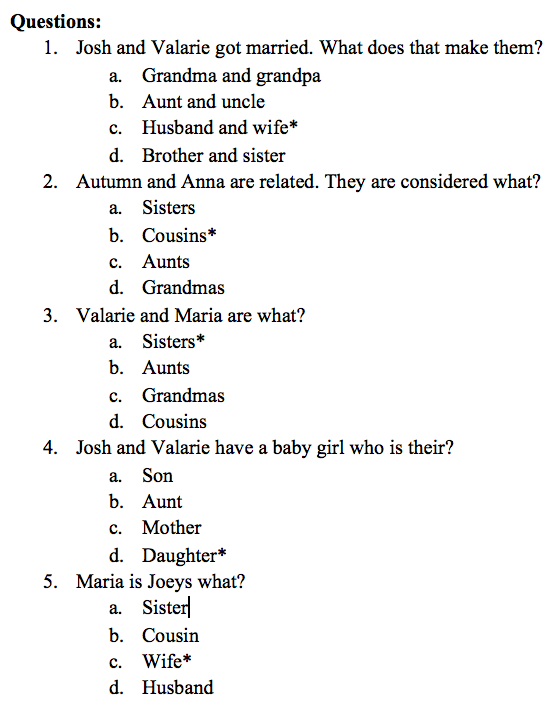Instructor: Kelly Boettcher
Class/Level: Beginner to intermediate learners, specifically geared towards children. Lesson is intended to build basic English abilities
Time: 50 minutes- 1 hour, depending on how in-depth the students take the discussion after some activities
Topic: All aspects of family; vocabulary, grammar, sentences, reading comprehension
Skills in Focus:
- Grammar- Family based vocabulary and how to alter specific relative names depending on the context of the sentence- sentence use
- Reading- scanning a paragraph and identifying familial relations- reading comprehension questions
- Speaking and communication with others- Working with fellow classmates to create individual family trees and fill in the blank on certain statements- students will participate in class wide discussions after ¾ of the activities
Goals:
- Family tree vocabulary and roles of each member of a family
- Answer reading comprehension questions by reading a paragraph and identifying the family relationships within the text
- Create a family tree based off of each individuals personal family’s
Objectives: By the end of the lesson students will be able to:
- Students will be able to accurately identify all family members and known relationships to one another
- Students will be able to understand a short passage regarding family members and be able to accurately identify the family members
- Students will be able to correctly understand a family tree and member relationships to one another
Materials:
- Vocabulary/ photo cards with family members on them(blank family tree will be drawn up on the white board by the teacher to place the vocabulary cards while learning them at the beginning of the lesson)
- Handout of a blank family tree
- Fill in the blank sentences with a word bank
- Handout with reading and reading comprehension questions
Class Description:
Vocabulary Learning (15 minutes)
Participation Framework: Whole class, specific students involves in writing on the front board. Objective #1
This first activity is essentially when the students are learning the new vocabulary for a family. There is not specific activity for the students to complete, rather it is meant for them to learn be taught the vocabulary and ask questions if needed.
- The teacher presents the basis of the lesson; family. The teacher then draws the outline of the family tree in Appendix A onto the white board in front of the class.
- The teacher explains that they will be creating a family tree while going through the family vocabulary to help them understand the terms better and see how everything fits into one big family.
- As the teacher explains each family member, a student is called upon to choose the correct family card and place it on the white board in front of the classroom. This is a way for the students to become involved and hopefully make inferences on one another’s choices.
- When the student places the correct name onto the whiteboard, the teacher instructs the students to say the family member name and relationships back to her in English.
- The teacher completes this with all of the family vocabulary cards.
- The teacher goes over the final family tree and asks the class if they have any questions or need any further clarification.
Essentially this is what the final product would look like to be drawn out on the white board. The general flow of a family tree and its members. Retrieved from https://freefamilytreetemplates.com/
Fill in the blank sentences (15 minutes)
Participation Framework: Groups of 3. Objective #3
- The teacher hands out the activity sheets that consist of 10 fill in the blank sentences that relate to different family members and where they are in the family tree.
- The teacher explains to the students the instructions for the worksheet and to come to the teachers if you are having trouble or have any questions.
- The students will work together, in groups of 3, to fill in the sentences to the best of their abilities.
- Once each group thinks they have correctly completed all of the sentences, the teacher will come over and check those answers.
- If the students got any of the questions wrong, they have to redo those sentences together with the teacher.
- The teacher will help them figure out the correct answer and explain why that answer was correct/ incorrect.
- Once all groups are finished, the teacher calls on different groups to say the answer to a question and so on.
- The teacher has the option to discuss answer choices to the class if she needs to.
Reading Comprehension (20 minutes)
Participation Framework: Individual to complete as much as they can, then collaborate with a partner. Objective #2
- The teacher passes out a worksheet with a reading passage on it and some questions to answer about the passage pertaining to the family relationships in the text.
- The students are instructed by the teacher to complete the activity as much as they can on their own, then once they complete what their ability can hold they are allowed to collaborate with a partner and finish the worksheet.
- The students are instructed to read the paragraph and answer the following questions. They are told to use their vocabulary and context clues to answer the questions accurately.
- The teacher gives the students 10-15 minutes to read and answer the questions.
- The teacher then calls on various students in their group to read a question and state their answer. Students are encouraged to be confident in their answer choice, as no one is going to be penalized for an incorrect answer.
- The teacher then goes over all of the answers and why the correct answer choice is appropriate. The teacher will use the text to explain all correct answers.
- If the students need further clarification, then the teacher will give it as needed.
Reading Passage: Once upon a time, Valarie was riding her horse at her family’s barn. Her horse got stunned by a frog and she fell of the horse. A man named Josh ran to her rescue to make sure she was okay. After making sure she was okay, Josh offered to take her to lunch. Valarie and Josh ended up falling in love shortly after the incident. A couple months later, Josh and Valarie got married. The next year, Josh and Valarie were expecting a baby girl together. They named her Anna. At the same time, Valarie’s sister, Maria, and her husband, Joey, had a baby girl. They named her Autumn. Together, Autumn and Anna wanted to grow up together and have happy families together on their own horse farms.
Creating personal Family Tree (15 minutes)
Participation Framework: Individual Assignment. Objective #1
- Each student is given a hand out to complete.
- The students are instructed to fill out their own families tree, if they can
- They can use the individuals real names or just their ‘indication’ (mother, father, brother, etc).
- The students are encouraged to communicate with their peers throughout the assignment, however all assignments will be individually completed.
- The students are asked to bring their family tree home and have their parents look over their work.
- Their parents will write on the sheet which ones are correct and which ones aren’t and explain to their child why the answer is correct/ incorrect.
- No grading for this activity is required.
The students will use this outline to create their own family tree. This is the same outline used at the beginning of the lesson when teaching the vocabulary, so this should already be familiar to the students.



